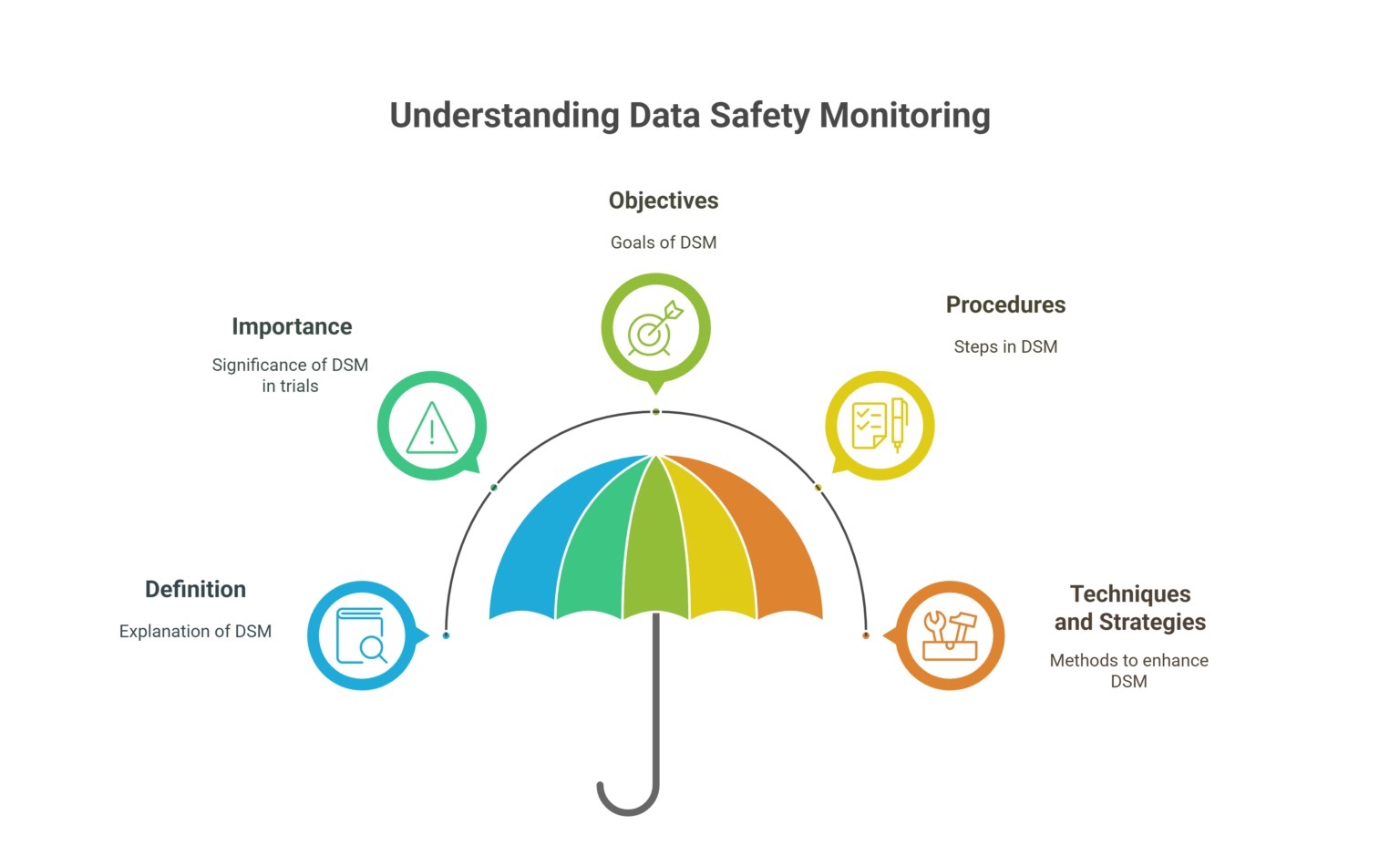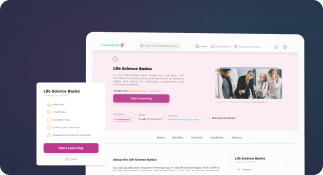In the world of clinical trials and research, ensuring the safety of data is more critical than ever. Data Safety Monitoring (DSM) is a vital process that protects patient information and upholds data integrity. This article takes a deep dive into the concept of Data Safety Monitoring, explaining its definition, importance, main objectives, and procedures. We also explore various techniques and strategies that can enhance the effectiveness of DSM in clinical settings.
Whether you’re a healthcare professional or a researcher, understanding these principles will help you safeguard vital data more effectively.

Definition and Procedure of Data Safety Monitoring
Data Safety Monitoring refers to the ongoing process of reviewing and overseeing clinical trial data to ensure its integrity, safety, and compliance with established regulatory standards. This continuous monitoring is designed to identify and address potential risks or issues that could compromise patient safety or the validity of the research. The primary goal of Data Safety Monitoring is to prevent any harm to trial participants while ensuring that the study remains in compliance with regulatory guidelines such as FDA, EMA, or ICH-GCP.
Sign up for Introduction to Pharmacovigilance Course
7 Main Categories of Data Safety Monitoring Procedures
Evaluate potential risks early in the process, considering patient safety, data integrity, and regulatory compliance.
Collect data in a timely manner, ensuring it is accurate and detailed for effective monitoring.
Regularly verify that the trial follows the applicable regulatory guidelines, such as GCP and FDA requirements.
Conduct interim data analysis to identify emerging trends or potential problems that could affect the study’s outcome.
Promptly report any data irregularities, adverse events, or safety issues to the relevant authorities.
Implement continuous checks and audits to ensure that data quality meets the required standards.
Gather feedback from stakeholders and incorporate it into the monitoring process to improve the overall safety and efficiency of the study.
Fast-track your career with VIP consultation
Data Safety Monitoring Techniques
Traditional Data Safety Monitoring Methods
Traditional Data Safety Monitoring techniques have been widely used in clinical trials for many years. These methods typically rely on periodic reviews and checks, conducted manually by a designated team.
Traditional approaches focus on ensuring data compliance through routine auditing and inspection. While these methods offer consistency, they can sometimes lead to delays in detecting issues and less efficient decision-making. Monitoring typically occurs at fixed intervals, which may limit the ability to respond to emerging risks in real-time.
One of the most significant challenges with traditional methods is their reliance on paper-based systems and siloed data. Data safety teams often have to manually compile and analyze large volumes of data, which can slow down the identification of issues.
As a result, critical information may be overlooked, putting both patient safety and study outcomes at risk. However, traditional methods are still used in many clinical trials due to their simplicity and familiarity.


Innovative Techniques in Data Safety Monitoring
Innovative techniques in Data Safety Monitoring integrate cutting-edge technologies such as Artificial Intelligence (AI), Machine Learning (ML), and automated data management systems. These tools offer real-time analysis of patient data, allowing researchers to detect issues almost immediately. AI-driven tools can analyze vast datasets, flagging any anomalies or discrepancies that may indicate a safety concern or data irregularity. Furthermore, these techniques help reduce the reliance on manual processes and paper-based systems, significantly enhancing the efficiency of monitoring activities.
Another innovation involves cloud-based platforms that allow real-time collaboration between data safety teams, clinicians, and researchers. These platforms store data securely while providing instant access to all authorized parties, regardless of location. This collaborative approach fosters quicker decision-making and allows stakeholders to respond promptly to any emerging safety concerns. Additionally, with improved data analytics capabilities, researchers can derive more meaningful insights, ultimately leading to safer trials and more reliable results.
Data Safety Monitoring Tools and Techniques
Automated Data Management Systems
These systems help streamline data entry, validation, and analysis, making the process more efficient and less error-prone.
Artificial Intelligence
AI-powered tools analyze large datasets quickly, identifying patterns and anomalies that require attention.
Electronic Case Report Forms (eCRFs)
eCRFs provide a secure, standardized way to collect and manage clinical trial data, ensuring accuracy and compliance.
Data Analytics Platforms
These platforms offer advanced analytics that enable real-time monitoring and decision-making based on current data trends.
Cloud-Based Monitoring Systems
Cloud systems allow multiple stakeholders to access data remotely, ensuring real-time updates and collaboration across locations.
Best Practices for Implementing DSM
Creating a Robust Data Safety Monitoring Plan
Developing a comprehensive DSM plan is essential for any clinical trial. The plan should clearly define monitoring responsibilities, outline the specific methods and tools to be used, and establish communication channels for reporting safety concerns. A good monitoring plan should also include contingency measures in case issues arise, providing a clear course of action when risks are identified. Additionally, the plan must adhere to regulatory standards and be flexible enough to adapt to evolving trial needs.
The DSM plan should be regularly updated as the trial progresses. As new data is collected, the monitoring strategies may need to be adjusted to reflect emerging trends or issues. This flexibility ensures that the monitoring process remains responsive to the study’s needs and continues to prioritize participant safety and data integrity. A well-developed monitoring plan helps the research team maintain high standards of safety and compliance throughout the trial.

Training and Engaging the Monitoring Team
Training is another crucial element for effective Data Safety Monitoring. Therefore, organizations must ensure that all team members receive thorough training on the DSM process, regulatory requirements, and monitoring tools. Without proper training, teams may struggle to identify risks, leading to compliance issues and data inconsistencies. Moreover, ongoing education allows professionals to adapt to evolving regulations and technological advancements. As a result, training should not be a one-time event but a continuous process that enhances team competency and preparedness. By investing in structured training programs, organizations can build a proactive workforce that confidently handles safety monitoring challenges.
Regular training sessions and workshops also help teams stay updated on new techniques, tools, and best practices. In addition, they encourage collaboration and knowledge sharing, which strengthens overall monitoring effectiveness. A well-prepared team can quickly identify potential risks, analyze data trends, and take immediate corrective action. Furthermore, fostering communication between data analysts, clinical teams, and safety officers ensures seamless coordination during safety assessments. When teams engage in regular meetings and feedback loops, they promote transparency and improve decision-making. Consequently, early detection of issues becomes easier, reducing the likelihood of costly errors or trial delays.
Main Objectives of Data Safety Monitoring
The primary objective of Data Safety Monitoring is to protect the safety and well-being of clinical trial participants. By continuously monitoring data, the DSM team can detect any signs of adverse reactions, complications, or safety concerns early in the trial.
This proactive approach allows for timely intervention and necessary adjustments to ensure that participants are not exposed to unnecessary risks. Monitoring also provides the opportunity to identify trends that could indicate a potential problem, making it easier to mitigate risks before they escalate.
Another critical objective of Data Safety Monitoring is maintaining the integrity and accuracy of the data collected throughout the trial. Inaccurate data can lead to incorrect conclusions and jeopardize the success of the study. By implementing robust DSM procedures, researchers can ensure that all data is valid, reliable, and consistent with the study’s objectives.
This also includes preventing data manipulation or fraud, ensuring transparency throughout the trial process, and maintaining trust among all stakeholders.
Main Challenges in Data Safety Monitoring
Data Volume and Complexity
Handling large volumes of data from multiple sources can be overwhelming, making it difficult to detect potential issues in real-time.
Regulatory Compliance
Staying up-to-date with constantly changing regulatory requirements, such as FDA, EMA, and GxP standards, can be challenging for teams.
Timely Risk Detection
Identifying risks quickly enough to take corrective action before they escalate is one of the primary difficulties in Data Safety Monitoring.
Lack of Resources
Many organizations struggle with limited staff or budget to implement comprehensive safety monitoring systems.
Integration of Technology
Incorporating advanced technologies such as AI or automated monitoring systems into existing processes can be complex and costly.
Ensuring Data Accuracy
Ensuring that data is accurate, consistent, and properly validated at every stage of collection and monitoring is a major challenge.
Conclusion
In conclusion, Data Safety Monitoring plays a crucial role in ensuring the success of clinical trials by safeguarding both patient safety and data integrity. By adopting the right tools, techniques, and strategies, clinical teams can identify and address potential risks early, keeping studies on track and compliant with regulatory standards. Whether you use traditional methods or embrace innovative technologies, the key to success lies in continuous monitoring and adaptability.
As we move towards more complex and data-driven research environments, Data Safety Monitoring will only
References

Ershad Moradi
Ershad Moradi, a Content Marketing Specialist at Zamann Pharma Support, brings 6 years of experience in the pharmaceutical industry. Specializing in pharmaceutical and medical technologies, Ershad is currently focused on expanding his knowledge in marketing and improving communication in the field. Outside of work, Ershad enjoys reading and attending industry related networks to stay up-to-date on the latest advancements. With a passion for continuous learning and growth, Ershad is always looking for new opportunities to enhance his skills and contribute to pharmaceutical industry. Connect with Ershad on Facebook for more information.

Pharma Industrial Training Certificate: Career Outcomes, Jobs, and ROI (2025)
A Pharma Industrial Training Certificate can significantly enhance your career in the pharmaceutical industry. This certificate equips you with hands-on experience in Good Manufacturing Practices (GMP), documentation, and manufacturing processes—skills that are directly applicable in various pharmaceutical roles.

Certificate in Pharmaceutical Manufacturing: Complete Career Guide (2025)
A Certificate in Pharmaceutical Manufacturing gives you a fast, structured way into GMP-based production roles. You learn core topics such as GMP rules, manufacturing processes, documentation, and QA/QC. In 6–12 months, you move from theory to shop-floor skills and boost your chances of landing a stable pharma job.

Computer System Validation in Pharma 2025 Guide
Computer System Validation in pharma keeps your digital systems reliable, compliant, and inspection ready. In this practical CSV guide for 2025, you learn core regulations (21 CFR Part 11, EU Annex 11, GAMP 5), step-by-step lifecycle activities, documentation expectations, and job-relevant skills so you protect data integrity and support safe, efficient pharmaceutical operations.





